
Nancy Reagan
Life & Times

1921 - 1929
Childhood Years
Overview
"I learned a lot about how to be a wife and about many other things, from my mother, Edith Luckett Davis. She had a profound influence on the woman I turned out to be, as did her second husband, Dr. Loyal Davis, whom I have always considered my true father."
-Nancy Reagan, My Turn

Nancy is Born in New York City
Born to a determined mother who acted on Broadway, Nancy’s fate was in her genes.

Nancy's Early Years
During her young years, Nancy was raised by her Aunt and their family while her mother traveled with the theater.

Nancy moves to Chicago
Nancy becomes a smart, fun-loving popular student.

1939 - 1964
Nancy & Ronald
Overview
"You know, if Nancy Davis hadn't come along when she did, I would have lost my soul."
-Ronald Reagan, My Turn.
"I've said it before and I'll say it again: My life didn't really begin until I met Ronnie."
-Nancy Reagan, My Turn

Nancy at Smith College
Nancy’s love of acting turns into a career.
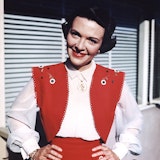
Nancy in New York
While breaking into acting, Nancy Davis spends time with friends like Katherine Hepburn, Lillian Gish and Clark Gable.

Nancy Moves to Hollywood
Nancy signs a seven year contract with MGM.

Nancy Meets Ronald Reagan
Courtship turns to marriage.

Nancy Davis Becomes Nancy Reagan
Patti and Ron are born.

Ronald Reagan’s Political Career Begins
Nancy Reagan actively campaigns on Ronald Reagan's gubernatorial trail.

1967 - 1975
Political Life
Overview
"When I married Ronnie, I thought I married an actor. But looking back now, I really should have known that acting wast fulfilling enough for him. But I honestly never expected that Ronald Reagan would go into politics."
-Nancy Reagan, My Turn

The Reagans Move to Sacramento
Ronald Reagan becomes Governor of California and Nancy works to ensure a safe living environment for her family.
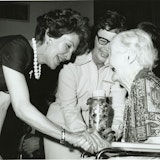
Foster Grandparents
Nancy’s sponsorship of Foster Grandparents helps bring national awareness to the program.
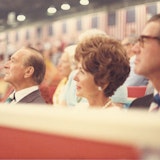
Nancy Reagan as First Lady of California
As First Lady, a newspaper calls her, “informed, interested and beautifully turned out day after day."

Welcoming Home Vietnam War POWs
Nancy focuses on giving Vietnam War Veterans the hero’s welcome they deserve.

Back Home in Southern California
Nancy campaigns on behalf of her husband to become President of the United States.

1981 - 1988
The Reagan Years
Overview
"Being first lady had taught me so much. Over those eight years in Washington, amid the exaggerated ups and downs of life at the White House, I found out what was really important to me. I learned how to serve... And for this, and for so many other things, I will always be grateful"
-Nancy Reagan, My Turn
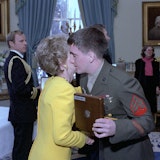
Celebrations and Memorials
President and Mrs. Reagan work to bring the nation together.
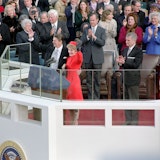
Settling Into the White House
First Lady Nancy Reagan focuses on restoring the White House.

The Assassination Attempt
“Honey, I forgot to duck.”

Foster Grandparents
Continuing her good work during the Gubernatorial Years, Nancy Reagan continues to promote and grow the Foster Grandparents Program.

The Royal Wedding
As the United States representative, Mrs. Reagan attends the Royal Wedding of Prince Charles and Lady Diana Spencer.
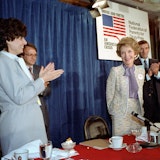
Just Say No
Responding to a young girl’s question about what to do when offered drugs, Mrs. Reagan answers, ‘Well, you just say no.’

Second Hand Rose
“First Lady Floors ‘Em With Song and Dance.”

Representing America Abroad
As part of her official duties, Mrs. Reagan represents America in over 20 trips all over the world.

“A Terrible Month”
Nancy Reagan fights breast cancer.

White House State Dinner in Honor of Mikhail Gorbachev
December 8, 1987White House State Dinner in Honor of Mikhail Gorbachev
“Nancy, much credit belongs to you, and I want to express to you your husband’s pride and your country’s thanks.”

Awards and Recognitions
“Nancy, much credit belongs to you, and I want to express to you your husband’s pride and your country’s thanks.”

1989 - 2004
Post Presidency
Overview
"I try to remember Ronnie telling me so many times that God has a plan for us which we don't understand now but one day will. It's hard but even now there are moments that Ronnie has given me that I wouldn't trade for anything. Alzheimer's so a truly long, long goodbye."
Nancy Reagan, I Love You Ronnie

Return to California
“This was really goodbye to Washington.”

Opening of the Ronald Reagan Presidential Library
5 Presidents and 6 First Ladies gather at the opening of the Reagan Library.

President Reagan is Diagnosed with Alzheimer’s Disease
Mrs. Reagan prepares herself for “truly a long, long goodbye.”

Republican National Convention
“Ronnie’s optimism, like America’s, still shines very brightly.”
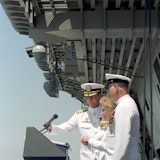
The USS Ronald Reagan (CVN 76)
“Man the ship and bring her to life.”

Post-Presidential Awards and Recognitions
Post-Presidential Awards and Recognitions: Congressional Gold Medal of Honor and Presidential Medal of Freedom

Advocating for Stem Cell Research
Nancy Reagan was honored by the Juvenile Diabetes Research Foundation at a special event. That evening, she stepped up to the podium and, in her first public statement on the subject, advocated for stem cell research.

The President’s Funeral
I know in my heart that man is good.
That what is right will always eventually triumph.
And there is purpose and worth to each and every life.